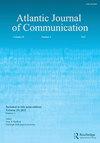Tweeting about the COVID-19 vaccine: A content analysis
IF 1
Q3 COMMUNICATION
引用次数: 0
Abstract
Twitter has been an influential and often controversial strategy for disseminating, discussing, and sharing information about the COVID-19 vaccine during the pandemic. This study focuses on using Twitter as a data collection and analysis tool to understand the narrative surrounding the COVID-19 vaccine in the days after the first emergency-use authorization (EUA). We conducted a content analysis of tweets we collected over a 30-day period (n = 419,495) and developed an iterative codebook that contained six domains (tweet source, location, tweet characteristics, COVID-19 specific topics, demographic descriptors, and sentiment) and thirty-six codes. Despite the abundance of misinformation on Twitter about the vaccine, we found that more tweets were positive than negative in tone and contained mostly reliable and up-to-date information about the vaccine. Most tweets came from individuals though many came from organizations. We found little discussion of demographic descriptors such as race/ethnicity, religion, or socioeconomic status, nor did we see discussion of misinformation or mask-wearing. Additionally, few tweets came from politicians or political organizations, and we found little talk of politics. This article contributes to the growing body of evidence of using Twitter to understand the narrative surrounding health topics during public health crises such as COVID-19. [ FROM AUTHOR] Copyright of Atlantic Journal of Communication is the property of Taylor & Francis Ltd and its content may not be copied or emailed to multiple sites or posted to a listserv without the copyright holder's express written permission. However, users may print, download, or email articles for individual use. This may be abridged. No warranty is given about the accuracy of the copy. Users should refer to the original published version of the material for the full . (Copyright applies to all s.)关于COVID-19疫苗的推文:内容分析
在大流行期间,推特一直是传播、讨论和分享有关COVID-19疫苗信息的一种有影响力且经常引起争议的策略。本研究的重点是使用Twitter作为数据收集和分析工具,以了解在首次紧急使用授权(EUA)后几天内围绕COVID-19疫苗的叙述。我们对30天内收集的推文(n = 419,495)进行了内容分析,并开发了一个迭代代码本,其中包含六个域(推文来源、位置、推文特征、COVID-19特定主题、人口统计描述符和情绪)和36个代码。尽管推特上有大量关于疫苗的错误信息,但我们发现,更多的推文在语气上是积极的,而不是消极的,并且包含了关于疫苗的大多数可靠和最新的信息。大多数推文来自个人,但也有许多来自组织。我们发现很少有关于人口统计学描述的讨论,如种族/民族、宗教或社会经济地位,也没有看到关于错误信息或戴面具的讨论。此外,很少有来自政治家或政治组织的推文,我们发现很少有关于政治的讨论。这篇文章提供了越来越多的证据,证明在COVID-19等公共卫生危机期间使用Twitter来理解围绕健康主题的叙述。版权归Taylor & Francis Ltd所有,未经版权所有者明确书面许可,其内容不得复制或通过电子邮件发送到多个网站或发布到listserv。但是,用户可以打印、下载或通过电子邮件发送文章供个人使用。这可以删节。对副本的准确性不作任何保证。用户应参阅原始出版版本的材料的完整。(版权适用于所有人。)
本文章由计算机程序翻译,如有差异,请以英文原文为准。
求助全文
约1分钟内获得全文
求助全文

 求助内容:
求助内容: 应助结果提醒方式:
应助结果提醒方式:


